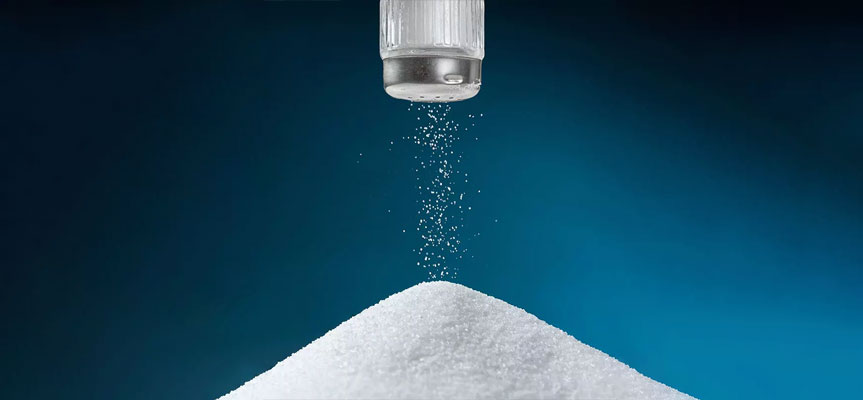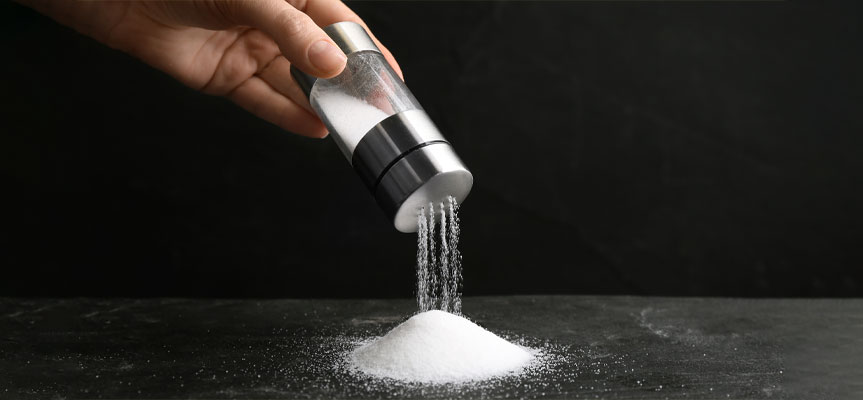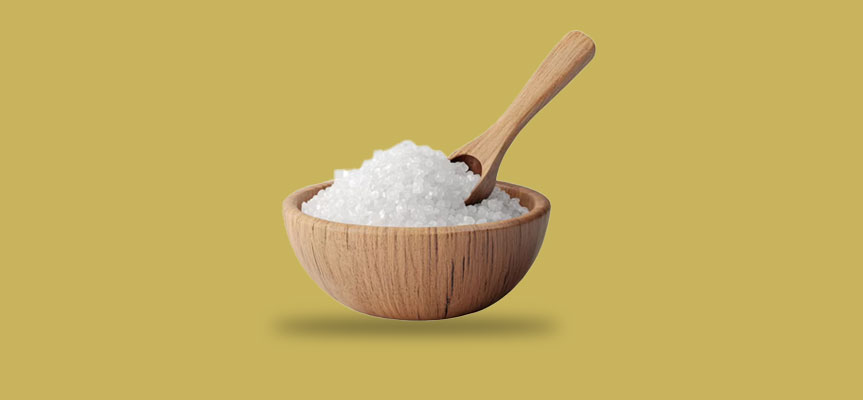Salt is one of the most widely used spices in the world and holds a special place in almost all foods. But have you ever thought about how the type of salt you consume affects your health? Excessive consumption of regular salt can cause serious health problems, especially high blood pressure and heart diseases. For this reason, low-sodium salt has been introduced as a healthier alternative. In this article, we take a closer look at low-sodium salt, its benefits, its differences with regular salt, and the main reasons to consume it.
What is Low-Sodium Salt?
Low-sodium salt is a type of edible salt with a significantly reduced sodium content. Unlike regular salt, which consists of about 90% sodium chloride, low-sodium salt usually contains a mixture of sodium chloride and potassium chloride or other substitutes designed to reduce the sodium load on the body. The reduction of sodium in this salt lessens the strain on the cardiovascular system and decreases the harmful effects of excessive sodium on the body.
Low-sodium salt is commonly available in two forms: one as edible salt with a lower sodium percentage, and the other as specialized food products recommended for individuals on specific diets. The primary goal of producing these salts is to maintain the taste of regular salt while providing greater health benefits and lower health risks.
So, what exactly is low-sodium salt and why was it created? The worldwide increase in salt consumption has caused many people to develop conditions such as high blood pressure, heart diseases, and kidney problems; therefore, replacing regular salt with low-sodium salt is an effective and simple strategy to reduce these issues.
What’s the Difference Between Low-Sodium Salt and Regular Salt?
Regular salt consists of approximately 99% sodium chloride, whereas in low-sodium salt, some sodium is replaced with potassium. This difference makes low-sodium salt a better option especially for those who need to control their sodium intake. Additionally, low-sodium salt has a taste similar to regular salt and can easily substitute it in cooking.
Why Should We Use Low-Sodium Salt?
Excessive consumption of regular salt, particularly its sodium content, is directly linked to various diseases such as high blood pressure, stroke, heart diseases, and kidney failure. When too much salt enters the body, it increases blood volume, thereby raising pressure on blood vessel walls, which can lead to serious complications.
Why use low-sodium salt? Because it contains significantly less sodium, which reduces the pressure on the cardiovascular system. This is especially important for people at risk of cardiovascular diseases. Low-sodium salt also helps maintain the body’s electrolyte balance and reduces the likelihood of issues like water retention and swelling.
Moreover, multiple studies have shown that even a small reduction in salt intake can significantly lower blood pressure and reduce the risk of heart attacks and strokes. Therefore, using low-sodium salt is recommended as a simple yet effective strategy to improve overall health.

Effect of Low-Sodium Salt on Blood Pressure
High blood pressure is a common and dangerous disease that can lead to heart attacks and strokes. Excess sodium intake raises blood pressure, but low-sodium salt, by reducing sodium consumption, helps control and lower blood pressure. Numerous studies have demonstrated that replacing regular salt with low-sodium salt can significantly reduce blood pressure.
Health Benefits of Low-Sodium Salt
The benefits of low-sodium salt are not limited to reducing dietary sodium. Below are the most important advantages of consuming this type of salt:
- Lowering Blood Pressure: The primary benefit of low-sodium salt is its ability to control blood pressure. Sodium reduction lowers pressure on blood vessel walls and decreases the risk of heart diseases.
- Prevention of Heart Diseases: Consuming low-sodium salt helps reduce cholesterol and fat accumulation in the vessels, minimizing the risk of cardiovascular diseases.
- Kidney Health Maintenance: Excess sodium increases the workload on kidneys and may lead to kidney failure over time; low-sodium salt helps lower this risk.
- Reduction of Water Retention: By lowering sodium intake, low-sodium salt prevents fluid accumulation in tissues and reduces unwanted swelling.
- Support for People with High Blood Pressure and Diabetes: These individuals must control their sodium intake due to special health conditions, and low-sodium salt is an effective tool for managing their health.
- Improved Quality of Life: Reducing the side effects of excessive salt consumption leads to better well-being and lowers the risk of chronic diseases.
Choosing the Best Low-Sodium Salt for Your Diet
Selecting the best low-sodium salt depends on several factors:
- Salt Composition: The best low-sodium salt replaces sodium chloride with substitutes like potassium chloride, which supports electrolyte balance and heart health.
- Taste and Flavor: One common concern is the taste difference between low-sodium and regular salt. The best low-sodium salts closely mimic the taste of regular salt, making them easier to use.
- Product Quality and Safety: Salts produced without chemical additives and impurities are preferable.
- Health Certifications: Salts approved by reputable authorities and recommended for special diets are better choices.
Brands like Grownida, known for innovation and healthy product manufacturing, provide high-quality, internationally-standard low-sodium salts suitable for various diets.

Low-Sodium Salt and Heart Health
One of the most important benefits of low-sodium salt is its positive impact on heart health. Reducing sodium in the diet lowers blood pressure and thus decreases the workload on the heart. This significantly reduces the risk of heart failure and stroke.
Low-Sodium Salt for People with Diabetes
People with diabetes must control their salt intake for several reasons. Diabetes affects kidney function and increases blood pressure, complicating the disease. The benefits of low-sodium salt for diabetics include:
- Blood Pressure Control: High blood pressure is a common complication of diabetes, and controlling it is essential to prevent serious damage.
- Preserving Kidney Function: Kidneys in diabetic patients are very vulnerable; reducing sodium through low-sodium salt helps protect kidney health.
- Reducing Heart Disease Risk: Diabetes increases the risk of heart diseases, so lowering sodium and using low-sodium salt help prevent these conditions.
- Regulating Fluid and Electrolyte Balance: Diabetes can disrupt body fluid balance, which low-sodium salt helps to restore.
For these reasons, nutritionists and doctors usually recommend that diabetic individuals use low-sodium salt and reduce their daily sodium intake.
Low-Sodium Salt and Reduced Risk of Heart Diseases
Heart diseases are one of the biggest public health challenges worldwide and have a direct connection to excessive salt intake. High sodium consumption leads to elevated blood pressure, vessel inflammation, and extra strain on the heart, eventually causing heart diseases.
Low-sodium salt helps reduce these problems by:
- Lowering Blood Pressure: Controlling blood pressure is the most critical factor in preventing heart diseases.
- Reducing Inflammation: Lower sodium intake reduces inflammation in vessel walls.
- Preventing Heart Failure: By reducing pressure and workload on the heart, the risk of heart failure decreases.
- Improving Blood Vessel Function: The balance of potassium and sodium in low-sodium salt enhances vessel function and overall heart health.
According to many studies, people who consume low-sodium salt have a lower risk of heart attacks, strokes, and other heart-related problems.
How Does Low-Sodium Salt Control Blood Pressure?
Sodium plays a key role in fluid balance and blood pressure regulation. Excessive sodium causes the body to retain more water, which raises blood pressure. Low-sodium salt reduces the sodium entering the body, improving this balance and keeping blood pressure within a healthy range.
Who Should Use Low-Sodium Salt?
Low-sodium salt can benefit most people but is especially recommended for:
- Individuals with high blood pressure who need to reduce sodium intake.
- People with heart and vascular problems or those at risk.
- Diabetics, due to kidney vulnerability and blood pressure concerns.
- Patients with kidney problems who must limit sodium.
- Children and the elderly, who are more sensitive to sodium and potassium balance.
- Those who want to reduce salt consumption for a healthier lifestyle.
However, using low-sodium salt should be done under medical or nutritional supervision to avoid disrupting mineral balance.

Does Low-Sodium Salt Have Side Effects?
Consumption of low-sodium salt is generally safe, but excessive intake of the potassium it contains can be dangerous for individuals with kidney problems. Therefore, it is better to consult a doctor before completely changing your diet.
Important Points About Consuming Low-Sodium Salt
To optimally benefit from low-sodium salt and avoid possible side effects, paying attention to the following points is essential:
- Consult a doctor: Especially if you have underlying conditions such as high blood pressure or kidney issues.
- Be mindful of potassium levels: Some low-sodium salts contain potassium chloride, and excessive potassium intake can also cause problems.
- Make the change gradually: It is better to gradually replace regular salt with low-sodium salt so the body can get used to the new taste.
- Control total salt intake: Even low-sodium salt should be consumed in moderation.
- Read product labels: Always check the ingredients and sodium content on the label.
- Maintain dietary balance: Consuming vegetables, fruits, and potassium sources alongside low-sodium salt is important.
- Avoid if allergic: People allergic to potassium should be cautious.
How to Increase Low-Sodium Salt Intake in the Daily Diet?
- Replace regular salt with low-sodium salt in cooking.
- Use spices and aromatic herbs to reduce the need for salt.
- Read food product labels and choose low-sodium options.
- Educate family members and friends about the importance of reducing sodium intake.
The Impact of Low-Sodium Salt on Improving Quality of Life
Switching to low-sodium salt not only improves physical health but also enhances overall quality of life. By lowering blood pressure and improving heart function, individuals gain more energy and strength for daily activities.
Additionally, the reduced risk of chronic diseases decreases anxiety and health-related worries, providing a greater sense of calm. Moreover, those who consume low-sodium salt generally experience better sleep and less stress.
Real-life experiences show that changing salt consumption and choosing low-sodium salt is a positive step toward maintaining long-term health and preventing unwanted problems.
Read more: Signs and Symptoms of Iodine Deficiency
Low-Sodium Salt and Kidney Health Support
The kidneys are responsible for regulating sodium and water levels in the body. Excessive sodium intake can increase the workload on the kidneys and cause serious damage. Low-sodium salt reduces this pressure and helps preserve kidney health.
The Role of Low-Sodium Salt in the Modern Diet
Modern diets are moving toward reducing regular salt consumption and replacing it with low-sodium salt or other substitutes. Due to the prevalence of diseases related to high sodium intake, low-sodium salt has become a key component in healthy nutrition plans.
The Grownida Innovation and Creativity Center, by offering high-quality low-sodium salt products, plays an important role in promoting a healthy lifestyle. These salts can be used in various dishes without any limitation in taste or application.
Furthermore, educating consumers and raising awareness about the importance of reducing sodium in the diet have given low-sodium salt a special place in the market and family food baskets.
Grownida Innovation and Creativity Center and Its Role in Producing Low-Sodium Salt
One of the leading brands in producing edible low-sodium salt is the Grownida Innovation and Creativity Center. This center uses modern technologies and health standards to produce high-quality, globally standardized low-sodium salt that can help consumers maintain their health.
Conclusion
Low-sodium salt is a smart and essential alternative to regular salt with significant health benefits. Reducing sodium intake through low-sodium salt helps control blood pressure, prevent heart diseases, maintain kidney health, and improve quality of life.
For individuals with chronic diseases such as diabetes and hypertension, consuming low-sodium salt is even more important and should be done carefully and with full awareness. Choosing the best low-sodium salt based on quality, ingredients, and health certifications plays a key role in the positive impact of this product.
Given the increasing trend of diseases related to salt consumption, replacing regular salt with low-sodium salt is an important step toward a healthy lifestyle and a better future for public health. It is recommended that everyone, especially those at risk, take low-sodium salt seriously and include it in their diet.
Frequently Asked Questions
Why is low-sodium salt better?
Low-sodium salt reduces the amount of sodium intake, helping to control blood pressure and reduce the risk of heart diseases.
Who is low-sodium salt suitable for?
People with high blood pressure, heart patients, diabetics, and those who want to reduce their sodium intake.
Does low-sodium salt have side effects?
Low-sodium salt consumption is usually safe, but people with kidney problems should consume it cautiously.
What is low-sodium salt and how is it different from regular salt?
Low-sodium salt is a type of salt that contains less sodium, with part of the sodium replaced by potassium.
How does low-sodium salt control blood pressure?
Reducing sodium decreases water retention in the body and lowers blood pressure, which helps control hypertension.

